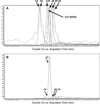Increased ceramide in brains with Alzheimer's and other neurodegenerative diseases
- PMID: 22258513
- PMCID: PMC3643694
- DOI: 10.3233/JAD-2011-111202
Increased ceramide in brains with Alzheimer's and other neurodegenerative diseases
Abstract
Ceramide has been suggested to participate in the neuronal cell death that leads to Alzheimer's disease (AD), but its role is not yet well-understood. We compared the levels of six ceramide subspecies, which differ in the length of their fatty acid moieties, in brains from patients who suffered from AD, other neuropathological disorders, or both. We found elevated levels of Cer16, Cer18, Cer20, and Cer24 in brains from patients with any of the tested neural defects. Moreover, ceramide levels were highest in patients with more than one neuropathologic abnormality. Interestingly, the range of values was higher among brains with neural defects than in controls, suggesting that the regulation of ceramide synthesis is normally under tight control, and that this tight control may be lost during neurodegeneration. These changes, however, did not alter the ratio between the tested ceramide species. To explore the mechanisms underlying this dysregulation, we evaluated the expression of four genes connected to ceramide metabolism: ASMase, NSMase 2, GALC, and UGCG. The patterns of gene expression were complex, but overall, ASMase, NSMase 2, and GALC were upregulated in specimens from patients with neuropathologic abnormalities in comparison with age-matched controls. Such findings suggest these genes as attractive candidates both for diagnostic purposes and for intervening in neurodegenerative processes.
Figures




References
-
- Pettus BJ, Chalfant CE, Hannun YA. Ceramide in apoptosis: An overview and current perspectives. Biochim Biophys Acta. 2002;1585:114–125. - PubMed
Publication types
MeSH terms
Substances
Grants and funding
LinkOut - more resources
Full Text Sources
Other Literature Sources
Medical

